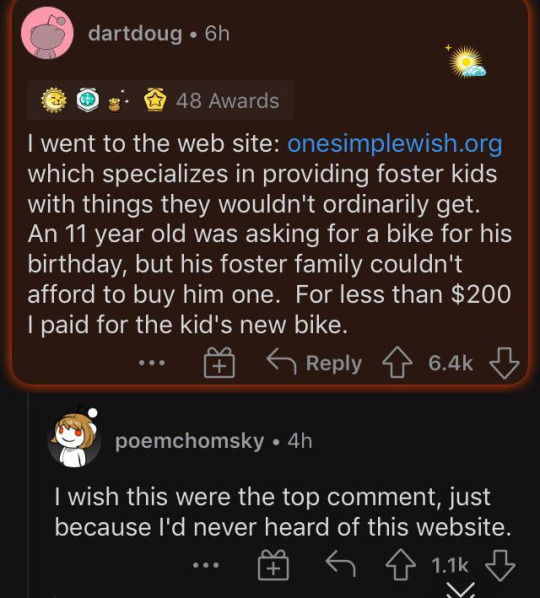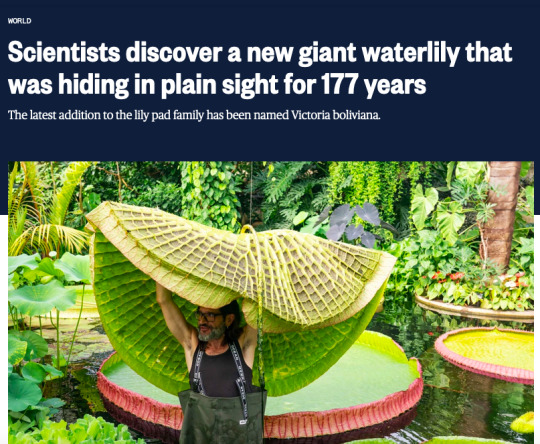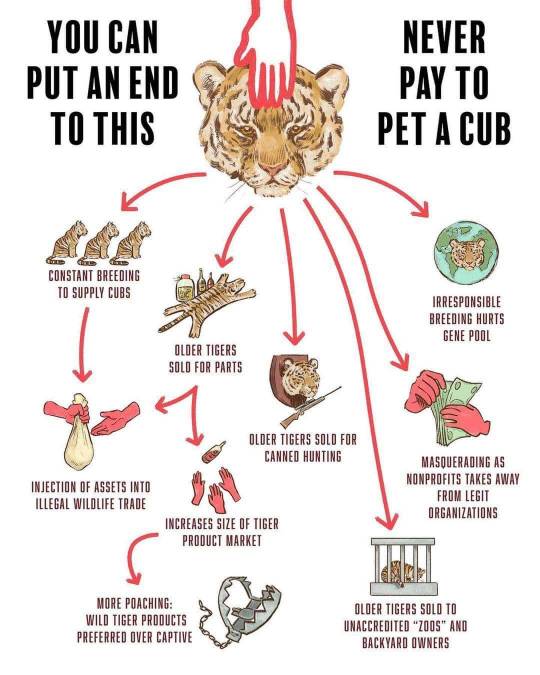Photo

Redditors crashed the website with donations over $25k and 0 wishes left. via /r/MadeMeSmile
Click here and follow to get more daily positivity on your dash!
207K notes
·
View notes
Text
382 notes
·
View notes
Text
Brazil’s Indigenous peoples mobilise against encroachment on their lands
As agribusiness, a slow legal system and Bolsonaro’s policies threaten lands, Indigenous peoples are fighting back

“Deni Farm, owner Edilson Pereira Duarte”; “Mato Grosso Farm, owner Vanderlei Martins de Oliveira”. These two signs, incorporating the Brazilian flag, are nailed to trees on either side of the road leading to Kapot village, in the Capoto/Jarina Indigenous Land, northern Mato Grosso state.
A barrier spans the road leading into Kapot. Drivers must get out of their vehicles and lift it to proceed, in contradiction to the legal requirement that access to Indigenous territory should be free and unhindered.
The signs and the barrier send a clear message. This land is private property and the law is not respected in these parts. Drones have shown that a plot of land in the area is already being cleared of trees. Will it join the gigantic soya or maize plantations that are advancing unchecked over these areas of tropical forest?
According to data from 2021, in the state of Mato Grosso, soya occupies some 9.8 million hectares and maize some 5.1 million hectares, a combined area equivalent to half the size of Belgium. Along with cattle pastures, these plantations already threaten to encircle this and many other Indigenous territories in the Brazilian Amazon, one of the country’s “agricultural frontiers”.
Continue reading.
250 notes
·
View notes
Text
Things you can do to help monarch butterflies, especially now that they’re endangered!
Don’t weed out milkweed, and don’t use pesticides on it. It’s the only plant that Monarch eggs are laid on, and keeping it alive as best you can helps more butterflies be born!
Research and plant nectar plants! This may not be possible based on your location and area, but if you don’t have a yard for it, local parks will respond if you contact them about volunteering to help plant! Nectar plants help feed butterflies on their long migrations from Canada and the USA to Mexico!
Donate to charities that help do things like plant milkweed and conserve butterfly forest habitat! Save our monarchs and Xerces Monarch Butterfly Conservation are a great start, but I encourage you to research on your own for charities that work for you!
Avoid pesticides! Pesticides can kill milkweed, and even kill the butterflies themselves! Monarch population is already down 90%, and even small steps like using crushed eggshell barriers and spraying pests away with water can be a great alternative!
If you can afford it, avoid genetically engineered foods. Many farmers use glyphosate resistant genetically engineered crops, so that they can spray more glyphosate and get rid of weeds. Glyphosate kills milkweed en masse, and runoff from rain often means the pesticide used isn’t contained to their farm, instead spreading into rivers and killing plants further out. This is environmentally catastrophic. (Not everyone can afford local produce, though, so I don’t hold this against you, nor do I hold using genetically engineered crops against farmers who can’t afford to do otherwise.)
508 notes
·
View notes
Text
i love you lab grown diamonds i love you slavery-free chocolate i love you community gardens i love you fact that the insulin patent was sold for $1 i love you locally produced meat and milk i love you streets turned into walkable parks i love you little reminders that Things Do Not Have To Be This Way and there are people working to build a better world!!
92K notes
·
View notes
Note
Apparently one of thoes giant lilypads at kew is an undiscovered species but nobody noticed


THE PLANTS CANT KEEP GETTING AWAY WITH THIS DUDE OH MY GOD THEY CANT JUST KEEP DOING THIS TO ME!!!!!!!!!!!!!!!!!!!!!!!!!!!
32K notes
·
View notes
Text
Please fucking lie to your employer. Like they don’t need to know your mental health issues or what drugs you do. Ffs
263K notes
·
View notes
Text

Source
[image description: image is a flow chart entitled " You can put an end to this: never pay to pet a cub" the chart starts with a drawing of a tiger cub head with a hand touching it. There are 6 arrows that flow from the start, in order from left to right:
1. Drawing of 3 small tigers, "constant breeding to supply cubs" arrow leads to image of a hand holding a sack with and a hand taking it, "injection of assets into the illegal wildlife trade"
2. Drawing of tiger skin rug and bottles, "older tigers sold for parts" arrow splits to two first leading back to "injection of assets into the illegal wildlife trade", and an drawn image of a bottle above 3 outstretched hands, "increases size of tiger product market" arrow to drawn image of a bear trap, "more poaching: wild tiger products preferred over captive"
3. Drawing of a mounted tiger head and a rifle "older tigers sold for canned hunting"
4. Drawing of tiger in very small barred cage, "older tigers sold to unaccredited zoos and backyard owners"
5. Drawn image of hands counting a large stack of money, "masquerading as non-profits takes away from legit organizations"
6. Drawing of the globe and a tiger head on it, "irresponsible breeding hurts gene pool"
End description. ]
3K notes
·
View notes
Text
Hey i’m a fashion design student so i have tons and tons of pdfs and docs with basic sewing techniques, pattern how-tos, and resources for fabric and trims. I’ve compiled it all into a shareable folder for anyone who wants to look into sewing and making their own clothing. I’ll be adding to this folder whenever i come across new resources
https://drive.google.com/drive/folders/16uhmMb8kE4P_vOSycr6XSa9zpmDijZSd?usp=sharing
126K notes
·
View notes
Text
68K notes
·
View notes
Link
if you see one of these things take one for the team and light it on fire
57K notes
·
View notes
Text
Planning for seed saving
I find that there’s not a lot of talk about how large a population you need when people do talk about seed saving. I think it’s a lot bigger than most people expect, especially for out-crossers like broccoli and corn. On top of that, if you want to be growing something different than your neighbors (or say, want to save broccoli seed when a lot of people let kale go to seed around you), you need to consider isolation distances. Let’s look at population size first.
Did you know that if you want to maintain the health and vigor of a particular kale variety, you need to grow out 20 to 50 plants? For long term genetic preservation, you need more than 80. For most suburban gardeners, that’s a lot! Not all plants need this many- but a lot of plants that are pollenated by the wind or insects do. On the other end, we have self-pollinating species, like lettuce, peas, and beans. For them, you only need to save seed from 5 to 10 plants to maintain a variety- which is much more manageable in a suburban garden.
Then, you have to consider isolation distance- and whether it’s even possible where you live. Isolation distance is basically how far apart two varieties need to be to prevent cross pollination. For example, if you had two different varieties of broccoli that you wanted to save seed from, they’d need to be separated by 800 feet to half a mile- which is pretty difficult in the suburbs. Especially once you consider that if someone else’s broccoli, cabbage, Brussels sprouts, or non-Siberian kale is flowering at the same time as your crop, there will be cross pollination if they’re within that distance (Siberian kale is actually a different species- same genus though).
Now, I want to save some Siberian kale seed, and I know that someone, who is less than half a mile from me always has a patch of Red Russian (a type of Siberian kale) that goes to seed. This has an upside, and a downside. The upside is a larger population and more genetic diversity- which, since kale is an outcrossed, should yield more vigorous plants. The downside is that I don’t know what, if any, intentional selection is going on with that patch of kale. I’ll be selecting for winter hardiness, tastiness, vigor, and pest resistance, but maybe they’re selecting for the ability to grow in crowded conditions, or being able to survive in a chicken run for 3 months. If I were growing a fussier plant, like Brussels sprouts, this might be enough to dissuade me from saving seeds, but since kale is such a hardy, unrefined plant anyway, I don’t think it will be a problem.
Where it becomes more of an issue is with pumpkins and squash. And that’s because there’s three (or four) different species that all have varieties called ‘pumpkin’ or ‘squash’. Did you know that zucchini and Delicata are the same species as the New England Sugar Pie pumpkin? Or that Kabocha, Banana, and Hubbard are all the same species? Fortunately, though they have a large isolation distance (because bumble bees love them), their population size is small (5 to 10 to maintain a variety), and it’s easy to tape close blossoms before they open and then hand pollinate.
If I were growing corn, it would be again, another consideration, because they are a) wind pollenated, b) need a very big population size, and c) if sweet corn pollenates popcorn, there'll be some issues. I'll probably keep buying corn seed.
I’m not trying to scare you off of saving your own seeds, I just want you to think about what you’ll need to do to maintain varieties. Here are a few resources that will help you do that:
https://www.communityseednetwork.org/resources/
Click to access SS-Seed-Saving-Chart-English.pdf
https://www.llojibwe.org/drm/greenteam/seedsaving.html
I also think people who maintain or develop new varieties are awesome, and here's some of my favorite seed sources:
Uprising Organics
Fedco Seeds
Territorial
West Coast Seeds
Johnny's
207 notes
·
View notes
Text
Reblog if you’d be okay if your friend came out as transgender
let’s see how many transphobics we can weed out
1M notes
·
View notes









